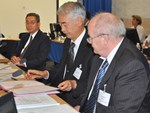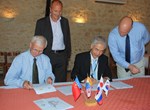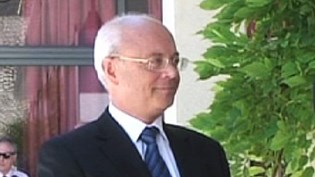A lot of legal work has been performed these past weeks at the ITER Organization.
On Tuesday 6 July the ITER site, while remaining CEA property, was
made available by notary deed to the ITER Organization. Less than three weeks later, ITER and CEA legal representatives met again in Paris to sign a sale deed for the existing site installations (Visitors Centre, technical buildings, storm basins, etc.).
By way of these two deeds, ITER now holds "full rights" to the land and buildings and will retain them for the duration of the ITER Agreement—that is, until 24 October 2042.
While the overall responsibility of the ITER site and existing buildings rests with the ITER Organization, actual construction work will be conducted mainly by Agence ITER France for the future Headquarters building; and by the European Domestic Agency (F4E) for all the buildings that constitute the ITER facility.
On 26 July, ITER Director-General Kaname Ikeda proposed to Jérôme Pamela, Director of Agence Iter France, to "delegate temporarily"—meaning until completion of the Headquarters building by the end of December 2011—the responsibility of health, safety, environment protection and logistics on the ITER worksite to Agence Iter France/CEA.
Three days later, Kaname Ikeda's successor Director-General Osamu Motojima and Frank Briscoe, Director of F4E, signed an agreement that made the ITER platform available to F4E in order to "undertake the construction of the ITER buildings and site infrastructure."
Complicated? "In appearance only," says Harry Tuinder, the Legal Advisor to the ITER Director-General. "Every large construction site—and ITER is one of the largest in the world—has to face this kind of challenge. We have set up an ITER Site Steering Committee that will coordinate, under our responsibility, Agence Iter France and F4E's activities on the worksite. Everything is now ready, and earlier than we expected, to enter the construction phase."






